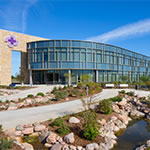“Hope is here.” That’s the message SwedishAmerican Health System hopes to communicate to patients and families through the nonprofit organization’s new LEED-certified Cancer Center. When the locally governed healthcare organization that serves northern Illinois and southern Wisconsin decided to consolidate state-of-the-art treatment and an award-winning cancer program under one roof, it created a support system that aims to make healing easier.
The project holds a number of firsts—it’s the first time a cancer center has received LEED for Healthcare certification in the United States, as well as Swedish- American’s first LEED endeavor. “We’re always trying to be a leader in our area,” says Glenn Evans, the organization’s director of facility planning, design, and construction. “Our organization has a vision statement that reads, ‘Set the standard of excellence for quality service and outcomes.’” By bringing this facility to northern Illinois, SwedishAmerican intends to demonstrate that it is conscious of not only the quality of care brought to its patients, but of the built environment as well.
To ensure that the project met its sustainability goals while maintaining high healthcare standards, Evans brought in Ringland-Johnson Construction—which has experience not only with LEED, but also with local health and American Society for Healthcare Engineering codes and regulations—as the project’s general contractor.

80 percent of construction waste was recycled, and 86 percent of the building materials were sourced within 500 miles of the project. All photos: Anna Brahmstedt Akerlund
The site is centralized in order to service the 12 counties near the health system’s headquarters in Rockford, Illinois, and is conveniently located off of the I-90 expressway. However, its location is on the eastern end of Rockford, so the SwedishAmerican Foundation introduced alternative transportation options for locals. Now, shuttle busses pick up patients from the hospital or their homes. Additionally, after negotiating with the city, the municipality now provides Rockford Mass Transit access directly to the center’s front door. On a building level, easy access was also a concern, with patient flow from department to department earmarked as a critical design element. Even though the building is set on two floors, there is abundant elevator access throughout the facility.

The center was designed with easy access to the outdoors in mind.

With interior elements that reference the cancer center’s prairie site, the building also uses 20% less water than a typical facility.

An advisory committee of cancer patients, cancer survivors, family members, physicians, technicians, architects, engineers, and contractors pitched in on what they wanted and didn’t want to see in a cancer facility.

Glenn Evans, SwedishAmerican’s director of facility planning, design, and construction, stressed the importance of providing a “homey, warm, open space.”
Early in project development, SwedishAmerican brought together an advisory committee consisting of cancer patients, cancer survivors, family members, physicians, technicians, architects, engineers, and contractors to determine what patients needed when they came into a cancer facility, as well as what elements they definitely did not want to see. The organization also visited the Carbone Cancer Center in Madison, Wisconsin, and similar facilities in Chicago. These measures made for an abundance of patient choices available in the center. The types of environments patients are offered give them the ability to freely transition between an open bay chemo area, a semi-private chemo area, and a private area. Typically, two of the three are present, but not all three. SwedishAmerican wanted to offer these choices, giving patients the ability to connect with other patients only if and when they felt comfortable.
“What sets this project apart from similar buildings is the condensed sustainable environment designed around the patients’ and families’ needs,” says Michael Vinci of Eckenhoff Saunders Architects (ESA), the project’s design architect. ESA worked closely with Saavedra Gehlhausen Architects, the project’s architect of record, to make spaces that were efficient from a patient’s point of view. “Treatment areas are comforting and flexible, allowing patients to control their environment,” Vinci says.
In order to make patients feel as if they are not stuck inside a hospital, the space was designed with easy access to the outdoors in mind. “It was important to provide a homey, warm, open space with direct access to nature,” Evans says, “so all of the treatment rooms have full window walls that look outside.” The positive atmosphere was extended all the way to the colors of the walls and the artwork on them. “Our biggest challenge was making it as patient friendly as possible, but I think we hit a homerun,” Evans says. By working closely with individuals affected by cancer on all levels from beginning to the end, SwedishAmerican has been able to create a precedent-setting facility that never loses sight of its mission to heal and help patients and their families.

